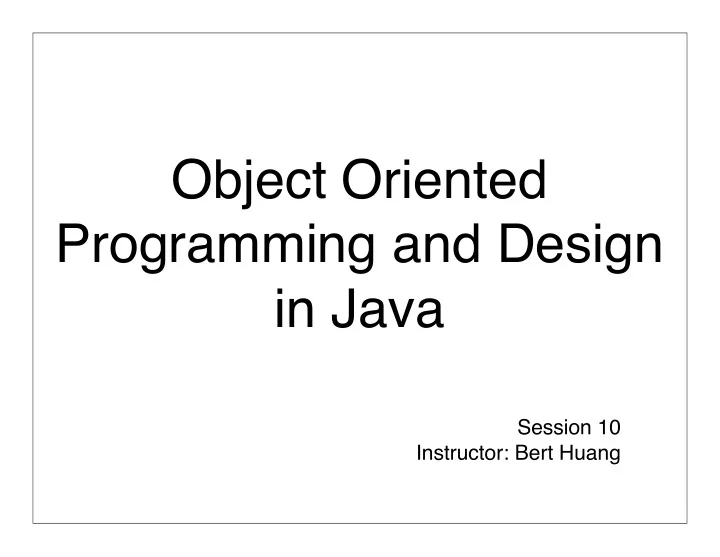

Object Oriented Programming and Design in Java Session 10 Instructor: Bert Huang
Announcements • Homework 2 due Mar. 3rd, 11 AM • two days • Midterm review Monday, Mar. 8th • Midterm exam Wednesday, Mar. 10th
Review • More LayoutManager examples • BorderLayout, BoxLayout, GridLayout • Discussion of Inheritance • Liskov's Substitution Principle • Polymorphism, encapsulation, preconditions and postconditions
Today's Plan • Inheritance and hierarchy • Abstract classes • Example hierarchies • Swing class hierarchy • awt.geom hierarchy • Exception hierarchy
Inheritance • Subclasses inherit methods and fields from superclasses • Analogous to taxonomies • In Java and most languages, subclasses can only inherit from one superclass
Phylogenetic Trees Superclass Animal Reptile Mammal Cat Dog Subclasses
Abstract Classes • Abstract classes are meant to be extended by various subclasses • The abstract class can never be instantiated • but methods and fields can be defined and implemented • A subclass can only extend one abstract class
Abstract Class Example • Suppose you make a HumanPlayer and ComputerPlayer class for a card game • CRC cards for both include • next move given game state • store score, cards • remember previous moves implementation will be the same
AbstractPlayer /** * Example class. Will not compile and features * a very incomplete design */ public abstract class AbstractPlayer { public AbstractPlayer() { myCards = new ArrayList<Card>(); score = 0; } public abstract Move nextMove(GameState game); public void addCard(Card c) { myCards.add(c); } public int getScore() { return score; } public void setScore(int newScore) { score = newScore; }
* a very incomplete design */ public abstract class AbstractPlayer { public AbstractPlayer() { myCards = new ArrayList<Card>(); score = 0; } public abstract Move nextMove(GameState game); public void addCard(Card c) { myCards.add(c); } public int getScore() { return score; } public void setScore(int newScore) { score = newScore; } public void addMove(Move newMove) { myMoves.add(newMove); } private score; private ArrayList<Card> myCards; private ArrayList<Move> myMoves; }
Template Methods • Not always obvious how to separate algorithms and implementations • Sometimes parts of algorithms are implementation specific, but the main flow is the same • Think of the main flow of the algorithm as a template
Saving a file • Format-free template method: • Open a file to be written • Translate object to be saved to text or binary format • Write text or binary to file • Close file
Pattern: Template Method • An algorithm is applicable for multiple types • The algorithm can be broken down into primitive operations . The primitive operations can be different for each type • The order of the primitive operations in the algorithm doesn't depend on the type • Define an abstract superclass that has a method for the algorithm and abstract methods for the primitive algorithms • Implement algorithm to call primitive operations in order • Leave primitive operations abstract or have basic default • Each subclass defines primitive operations but not the algorithm
Template vs. Strategy • Template Method is very similar to Strategy • Strategy delegates entire algorithm to the strategy object • Template method delegates small pieces: the primitive operations
Swing Components abstract classes
JTextComponent • int getSelectionEnd() • int getSelectionStart() • String getText() • void setText() • void paste() • void setEditable(boolean) • boolean isEditable()
AWT Shapes abstract classes
Rectangle2D • Rectangle2D has two inner classes • Let's clients choose tradeoff between precision and memory • Most work is done inside Rectangle2D (using double precision!)
public class Rectangle2D { public static class Float extends Rectangle2D { public double getX() { return x; } public double getY() { return y; } public double getWidth() { return width; } public double getHeight() { return height;} // ... public float x; public float y; public float width; public float height; } public static class Double extends Rectangle2D { public double getX() { return x; } public double getY() { return y; } public double getWidth() { return width; } public double getHeight() { return height;} // ... public double x; public double y;
public static class Double extends Rectangle2D { public double getX() { return x; } primitive public double getY() { return y; } operations public double getWidth() { return width; } public double getHeight() { return height;} // ... public double x; public double y; public double width; public double height; } public boolean contains(double x, double y) { double x0 = getX(); Template double y0 = getY(); Method return x >= x0 && y >= y0 && x < x0 + getWidth() && y < y0 + getHeight(); } // ... }
Exceptions
Hierarchy • With some foresight, you can design inheritance hierarchy for classes • Otherwise, when you find redundant functionality, refactor into hierarchy after or during coding
Reading • Today: • Horstmann Ch. 6 • Wednesday: • Horstmann Ch. 7.1-7.6
Recommend
More recommend